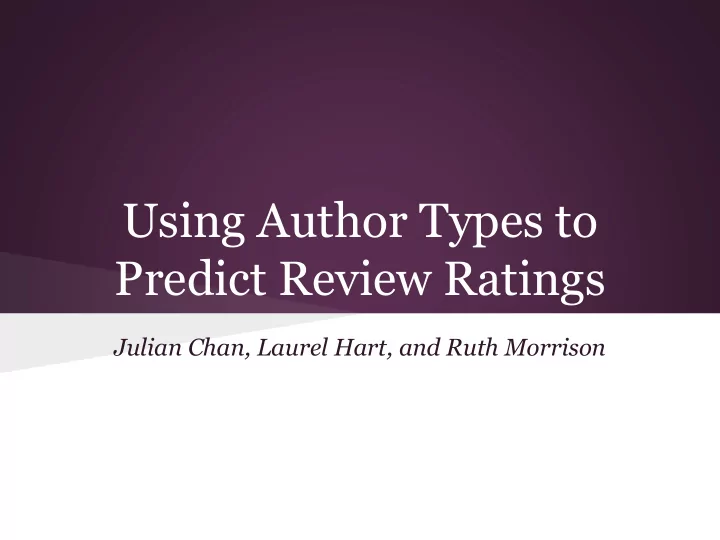

Using Author Types to Predict Review Ratings Julian Chan, Laurel Hart, and Ruth Morrison
Goal ● Predict rating of review based on review text ● Intuition: “dogs of the same street bark alike” -- authors with similar styles will rate similarly ● Amazon review corpus (Bing Liu et. al) ● Mallet for classification (MaxEnt classifier)
Features ● N-grams o unigrams, bigrams, trigrams, 4-grams, and 5-grams o top discriminating n-grams ● Author profile o Previous rating behaviors ● Stylistic features o Review length, negation, readability ● Miscellaneous o product type/genre path
Author Rating Pattern Clustering • Each author represented by a 5- dimensional vector. • Hierarchical clustering from 10000 author samples. • Cosine distance between author vectors
Five Clusters
Ten Clusters
Evaluation Strict accuracy is not that informative. • Credit should be given to a close guess. • Wildly inaccurate guesses should be • penalized more harshly. Solution: Mean Squared Error •
Using Five-Cluster Author Type as Feature AllBigrams 1 2 3 4 5Total Squared Error Instances MSE 1 39647 2613 2715 2834 48005 807059 95814 8.423184503 2 11912 4569 7976 6798 31807 333343 63062 5.285956678 3 5881 3132 14731 21955 55344 269987 101043 2.672001029 4 3828 1201 8532 44456 173848 221636 231865 0.955883812 5 5831 857 3372 25533 631164 140030 666757 0.210016543 1772055 1158541 Overal MSE 1.529557435 Normalized MSE 3.509408513 AllBigrams and 5-cluster Author-Type 1 2 3 4 5Total Squared Error Instances MSE 1 40280 2850 3975 3688 45021 772278 95814 8.0601791 2 11663 3925 8943 7862 30669 328075 63062 5.20241984 3 6018 2533 14914 23721 53857 265754 101043 2.63010797 4 4367 1133 9221 47582 169562 222618 231865 0.96011903 5 7520 1007 4663 29703 623864 177738 666757 0.26657088 1766463 1158541 Overal MSE 1.52473067 Normalized MSE 3.42387937 It helped *a little bit*…
Our best results so far AllCaseInsensitiveBigramsBalanced 1 2 3 4 5Total Squared Error Instances MSE 1 67172 16111 4549 2255 5727 146234 95814 1.5262279 2 18318 23840 12458 4144 4302 86070 63062 1.364847293 3 12514 20282 37062 20061 11124 134895 101043 1.335025682 4 16291 13824 42706 85784 73260 317881 231865 1.370974489 5 51675 16602 32257 111473 454750 1216719 666757 1.824831235 1901799 1158541 Overall MSE 1.641546566 Normalized MSE 1.48438132 • Rebalanced training data by down-sampling • Using case-insensitive bigrams results in error reduction • Incorporating author-profile actually resulted in performance degradation. • We tried trigrams, tetragrams, and fivegrams. Nothing beat good ol ’ bigrams. • A disproportionate number of 5s got classified as 1s. Perhaps some negation resolution could help here.
Human Performance ● We set up a website showing ten reviews to viewers and asked them to guess the ratings. ● Accuracy of 57.78% ● Mean Squared Error of 0.7889 ● Humans haveHuman much better MSE. ● MaxEnt had better accuracy on unbalanced training data, simply because it guessed 5- star more often. ● MaxEnt has similar accuracy as human when trained on balanced data.
What influences author-type? We found more than 50% of the data are 5-star reviews. Most authors also only give 5-star reviews. Could that be influenced by things like location, time, day of week, etc? For example, do Americans generally give more positive reviews than people in the UK?
In Summary… Nothing beats balanced case-insensitive bigrams (so far), but we’re still investigating certain style features (negation, length, readability). We could explore giving author-type features more weight instead of just throwing everything into MaxEnt
Recommend
More recommend